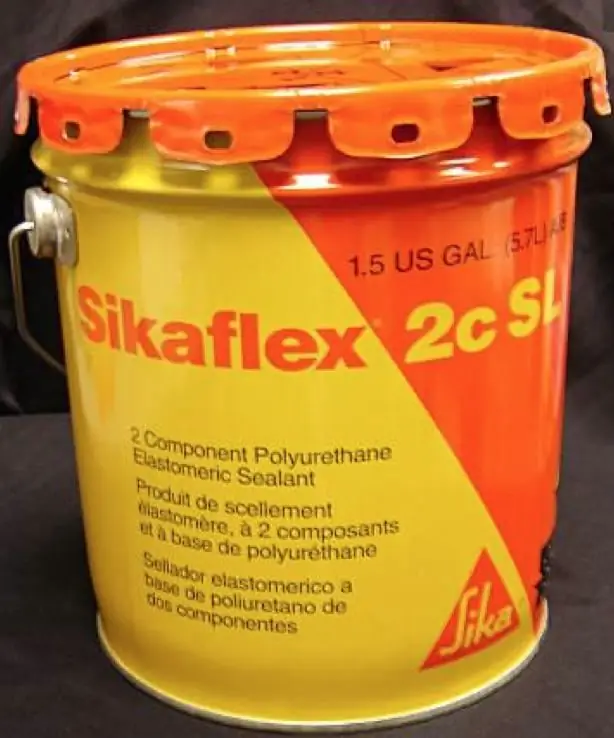2026 Author: Howard Calhoun | [email protected]. Last modified: 2025-01-24 13:10:29
Wear is understood as the gradual destruction of the friction surfaces of various pairs. There are many types of wear. They are due to various reasons. But they all have one thing in common - the particles are separated from the base material. This leads to a disruption in the operation of the mechanisms, and in other cases can cause their breakdown. The gaps in the joints increase, the landings begin to beat as a result of the formation of a significant backlash. This article discusses the main types of wear, gives their characteristics and general classification.

Features of abrasive wear
An abrasive is a finely dispersed material of natural or artificial origin, which has a significant hardness sufficient to scratch other less hard materials.
Type of surface wear, in which there is a destruction of the structure and integrity of the surface layer wheninteraction with solid microparticles is called abrasive. It should be canceled that for this kind of destruction, the friction velocity must be very significant (several meters per second). Although with prolonged operation, destruction occurs even at lower speeds and clamping forces.
The role of abrasive substances can be both fixed objects (solid phases of steels and alloys) and moving foreign particles that have fallen into the contact zone of rubbing surfaces (sand, dust and others).
The following factors influence the amount of abrasive wear and its intensity:
- nature of origin of abrasive particles;
- mechanism operating environment (degree of aggressiveness);
- material properties of friction pairs;
- impact loads;
- temperature indicators and many others.

Abrasion with hard particles (grains)
This type of mechanical wear occurs when abrasive grains come into contact with metal or other material. The hardness index of such particles significantly exceeds the hardness index of the metal itself. This leads to deformation of materials of friction pairs, occurrence of fatigue stresses, and surface abrasion.
If the mechanism works under conditions of frequent alternating loads, then the effect of the harmful effects of the abrasive is enhanced. In this case, the abrasive particle leaves not only marks, but also dents on the metal surface.
With an increase in the fraction of the abrasive substance, theabrasive wear. The abrasive particles are very hard, but at the same time brittle. Therefore, large bodies can be ground into smaller ones.

Features of oxidative wear
This type of wear occurs when a loose film of oxides appears on the surface of rubbing parts, which is quickly removed from the surface as a result of friction. Most engineering materials tend to oxidize in air at elevated temperatures. Therefore, mechanisms that operate without lubrication and without a cooling system are subject to this type of wear of parts.
The greater the rate of destruction of the oxide film and the greater the rate of its formation, the more intense the wear of the surfaces.
This type of wear is typical for hinged and bolted joints, various suspension mechanisms, and indeed for all units operating without lubrication.
With the increase in the speed of friction, the temperature of the rubbing surfaces increases. This leads to the intensification of destructive processes. An increase in shock loads has a similar effect.

Wear due to plastic deformation
This type of wear of machine parts is typical for highly loaded units. Its essence lies in changing the geometric shapes of the product under the influence of significant loads.
It is most typical for keyed and splined connections, as well as threads, pins, and so on.
Similardeformations can also occur in gear joints. And they don't have to be fast. Load is the key factor here.
Often such deformations appear on the rails and wheels of the rolling stock. To prevent, it is necessary to organize timely prevention and examination of structural elements.

Wear due to chipping
The presented classification of types of wear will not be complete if we lose sight of the so-called wear as a result of chipping. Its essence is as follows. Under severe (perhaps even extreme) operating conditions, the surface layers of rubbing parts undergo structural and phase transformations. The reasons in different cases are elevated temperatures, heating and cooling conditions, high pressure, and others. The properties of the resulting layers differ significantly from those of the original material. As a rule, these phases are brittle and break under load.
Thus, characteristic white stripes form on steel and cast iron during friction without lubrication. These areas cannot be etched even with a solution of nitric or hydrofluoric acids in alcohol. Specialists in the field of metal science call this formation a white layer. It has a fairly high Rockwell hardness and is very brittle. One laboratory performed phase and structural analysis of the white layer. It turned out that it is a mechanical mixture of martensite and cementite. It also contains a small amount of ferrite. The last thing in it at allsmall and it cannot reduce the hardness.
The formation (synthesis) of this substance is accompanied by the appearance of harmful internal tensile and compressive forces. When the vectors of internal stresses coincide with external loads on the part, small cracks form on its surface in the area of the white layer. These microcracks are stress concentrators and accumulators, which leads to brittle fracture of the product as a whole.
Wearing by Fetting Corrosion
This process occurs on surfaces that are in close contact with each other. The reason is fluctuations. It should be noted that the materials of the bodies of the friction pair can be very different (metal-metal or non-metal-metal).
This phenomenon occurs already at minimal displacements of bodies (of the order of 0.025 micrometers).
As a result of fluctuations, corrosion centers appear on the surfaces, which grow and lead to the destruction of the surface layer.
Wear by vibratory cavitation
This type of wear occurs when products operate in a liquid medium. Although it can also occur when a liquid jet hits a part of a machine or mechanism. The physics of the process is as follows. The liquid pressure at the phase boundary (between liquid and solid) drops, which leads to the appearance of so-called cavitation bubbles. The intensity of this wear depends on the air content in the fluid and on the external pressure.
A sound vibration can serve as a catalyst. Especially harmful in this case are fluctuations in the ultrasonic spectrum. Very often, such a harmful phenomenon occurs in the rubbing parts of internal combustion engines. Research shows that sonic cavitation wears out three to four times faster than friction.

Wear due to thermal cracking
This problem is typical for the wheels of railway cars and locomotives. During the movement of the train, the driver often has to slow down. This causes the wheels to slip and heat up. When picking up speed, the rubbing surface cools down rather quickly. Such thermal cycling leads to the formation of many cracks on the surface of the wheel. This significantly accelerates the wear of the product. Currently, special alloy steels are used for the production of railway wheels. But earlier steel of ordinary quality was used. Old wheels are still used on many trains today, so this problem is still relevant.
Ways to deal with thermal cracks
The most effective measure to combat thermal cracks will be to provide intensive cooling. Special oils and greases can be used for this. In the case of train wheels, this measure, for obvious reasons, is not suitable. In this case, you can play on the chemical composition of the material and choose a more favorable steel grade from this point of view. Certain grades of alloy steels have a low coefficient of expansion. And this property can be used to advantage.
Someerosion wear features
Considering the types of friction and wear, we cannot lose sight of the so-called erosion wear. In simple terms, this is the destruction of surfaces under the influence of the environment.
In engineering, this concept refers to the destruction of the surfaces of machine parts and mechanism assemblies under the influence of environmental factors. Such influence factors include air and liquid flows, steam or various gases. The cause of wear is, as before, friction. Only in this case, not abrasive particles, but gas or liquid molecules act on the surface.
Microcracks appear during this process. Molecules of liquid and steam under high pressure penetrate into them and contribute to the destruction of all surface layers of products.
Liquid or steam may also contain abrasive particles in suspension. In this case, such a mixture will cause abrasive-erosive destruction and wear.

Fatigue wear and its characteristics
Types of wear and geometry violations are very diverse. Many problems for design engineers and mechanical engineers are caused by fatigue spalling of the surfaces of parts. This "ailment" is very insidious. The phenomenon of fatigue spalling occurs in parts that operate for a long time under conditions of alternating loads. This is a characteristic "disease" of the gear joints.
This type of wear is accompanied by the initiation of cracks on the surface and their penetrationdeep into the product. On an insignificant surface area, a whole network of such microcracks appears. Under the influence of pressures and temperatures, small disparate pieces of metal peel off from the main body and fall off. An important role in this process is played by lubricant (oil), which penetrates into microcracks and promotes destruction.
Recommended:
Tax and tax payments - what is it? Classification, types, concept and types

Currently, the tax system is a set of taxes and fees established by the current legislation of the Russian Federation, which are levied in the budgets of different levels. This system is based on the principles provided by law. Let us consider in more detail the issues of essence, classification, functions and calculation of tax payments
Wear. Types of wear and classification

What is wear and tear? Types of wear - how many are there? These questions are simple at first glance, but there are subtleties. This applies to both the very concept of "wear" and everything related to it
Main types and types of business plans, their classification, structure and application in practice

Each business plan is unique, because it is developed for certain specific conditions. But you need to familiarize yourself with the features of various types of business plans in order to understand their key features. Experts recommend doing this before compiling your own similar document
Two-component polyurethane sealant: definition, creation, types and types, characteristics, properties and nuances of application

With long-term and high-quality sealing of seams and cracks, polyurethane two-component sealants have found their wide distribution. They have high deformation and elastic properties, therefore, they can be used as butt sealants in the field of repair and housing construction
Roll mills: photo, description, characteristics, disadvantages and wear

In various sectors of the national economy and industry, the finest grinding of materials is required. These can be food enterprises, and factories of heavy industry, grinding coal with semi-anthracite and all kinds of waste. And in each case, the task is to provide technical support for this operation with minimal organizational costs. Such requests are met by a medium-speed roller mill, which combines optimal power and design characteristics

